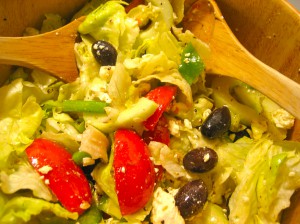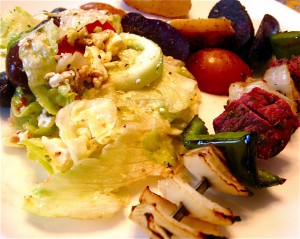Sun 28 Nov 2010
Kung Pao Shrimp
Posted by Recipe Sleuth under Favourites
No Comments
This is the first recipe I made from my first issue of Cook’s Illustrated, which I began reading in September 2002. It has been a favourite ever since. Juicy shrimp are stir fried with peanuts and whole chiles and then combined with garlic, ginger and a delicious sauce. It is great on its own, or served over steamed rice.
While the ingredient list might seem long, once you have everything assembled this dish cooks in less than 10 minutes. Make sure your pan is very hot, so that the ingredients brown instead of steam. Cook’s Illustrated recommends using a 12-inch, non-stick skillet for stir fries, which works very well.
To avoid additives and preservatives in this recipe, you will need to make hoisin sauce and oyster sauce from scratch. I’ve included my recipes for these two sauces below. Also make sure the chicken broth, rice vinegar, sesame oil and shrimp are additive-free.
Ingredients:
1 pound extra-large shrimp (21 to 25 count), peeled and deveined
1 tablespoon dry sherry or rice wine 2 teaspoons soy sauce
3 medium cloves garlic, pressed through garlic press or minced (about 1 tablespoon)
½ inch piece fresh ginger, peeled and minced (about 2 teaspoons)
3 tablespoons peanut oil or vegetable oil
½ cup roasted unsalted peanuts or cashews
6 small whole dried red chiles (each about 1 ¾ to 2 inches long), 3 chiles roughly crumbled, or 1 teaspoon dried red pepper flakes
¾ cup low-sodium chicken broth
2 teaspoons black rice vinegar or plain rice vinegar
2 teaspoons toasted sesame oil
1 tablespoon oyster sauce (see below for additive-free version)
1 tablespoon hoisin sauce (see below for additive-free version)
1 ½ teaspoons cornstarch
1 medium red bell pepper, cut into ½-inch dice
3 medium scallions, sliced thin
Hoisin Sauce
4 tbsp. Tamari soy sauce
2 tbsp. all-natural peanut butter
1 tbsp. honey or unsulphured molasses
2 tsp. white vinegar
1/8 tsp. garlic powder
2 tsp. sesame seed oil
1 tsp. Tabasco sauce
1/8 tsp. pepper
Oyster Sauce
1 ½ tbsp. Tamari soy sauce
1 tbsp. sugar
1 ½ tsp cornstarch
Preparation:
Toss shrimp with sherry and soy sauce in medium bowl; marinate until shrimp have absorbed flavors, about 10 minutes. Mix garlic, ginger, and 1 tablespoon oil in small bowl; set aside. Combine peanuts and chiles in small bowl; set aside. Mix chicken broth, vinegar, sesame oil, oyster-flavored sauce, hoisin sauce, and cornstarch in small bowl or measuring cup; set aside.
Heat 1 tablespoon oil in 12-inch skillet over high heat until just beginning to smoke. Add shrimp and cook, stirring about once every 10 seconds, until barely opaque, 30 to 40 seconds; add peanuts and chiles, stir into shrimp, and continue cooking until shrimp are almost completely opaque and peanuts have darkened slightly, 30 to 40 seconds longer.
Transfer shrimp, peanuts, and chiles to bowl; set aside. Return skillet to burner and reheat briefly, 15 to 30 seconds. Add remaining 1 tablespoon oil, swirl to coat pan, and add red bell pepper; cook, stirring occasionally, until slightly softened, about 45 seconds. Clear center of pan, add garlic-ginger mixture, mash into pan with spoon or spatula, and cook until fragrant, 10 to 15 seconds; stir into peppers until combined. Stir broth mixture to recombine, then add to skillet along with reserved shrimp, peanuts, and chiles; cook, stirring and scraping up browned bits on bottom of pan, until sauce has thickened to syrupy consistency, about 45 seconds. Stir in scallions; transfer to serving plate and serve immediately. Serves 4.
From the September 2002 issue of Cook’s Illustrated






















